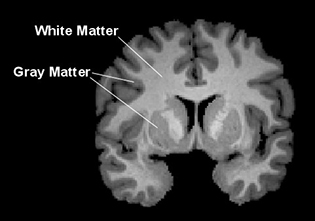|
|
PKU effect on brain more extensive than thought
The "heel stick" test is given at birth to every infant in the USA in order to detect Phenylketonuria (PKU). One in 10,000 children are found to have PKU, which is then treated through a restricted diet. Its rarity and relative ease of treatment has lead PKU to seldom be studied since the late 1960s.
PKU is a rare genetic disorder passed by mutated genes from both parents to their children. Currently the primary way to manage the disease is by restricting it in diet as phenylalanine, a "building block" of protein, is found in many foods high in protein — such as eggs, milk, nuts and meats.
Now, researchers at the University of Missouri, are using magnetic resonance imaging (MRI) to learn more about the effects of PKU disorder on the brain. Their goal is to help develop therapeutic drugs to treat and control PKU.
PKU is a condition in which the body cannot metabolize phenylalanine an amino acid, turning it into tyrosine — a precursor to dopamine and other neurotransmitters.
Without treatment, phenylalanine builds up and can cause severe health problems such as lack of muscular control, seizures, behavior problems and intellectual disabilities.
Once identified, patients with PKU are placed on a restricted diet to limit the amount of phenylalanine they eat, which lessens the impact of the disorder.
The research is published in Molecular Genetics and Metabolism and was funded by the National PKU Alliance.
"A majority of the studies surrounding early-treated PKU examined the effects seen in the white matter of the brain. Only a handful of studies investigated the effects of PKU on gray matter. We decided to add to the body of knowledge on this understudied aspect in PKU."
Shawn Christ PhD, Associate Professor of Psychological Sciences, Missouri University (MU) college of Arts and Science, and Director of the Brain Imaging Center.
Gray matter is located on the surface of the cerebral cortex and includes deep brain structures such as the thalamus and basal ganglia. White matter is located beneath the gray matter of the cerebral cortex and is made up of long neural pathways responsible for transferring information for processing between gray matter regions.
Phenylalanine is a precursor to tyrosine — a neurotransmitter for dopamine, norepinephrine (noradrenaline), and epinephrine (adrenaline), and the skin pigment melanin. Is is used in treatment of depression, attention deficit-hyperactivity disorder (ADHD), Parkinson's disease, chronic pain, osteoarthritis, rheumatoid arthritis, alcohol withdrawal symptoms, and a skin disease called vitiligo. It is even sold as a nutritional supplement for its analgesic and antidepressant effects.
Few past examinations of the potential effects of PKU on gray matter have occurred and were limited by technology of the time. In this recent study, Shawn Christ PhD, associate professor of psychological sciences, in the MU college of Arts and Science and director of the MU Brain Imaging Center, along with his colleagues combined advancements in MRI imaging with detailed manual analysis of the MRI data. They spent nearly two years mapping the gray matter of more than 40 individuals with and without PKU.
In their examinations, brain abnormalities were found in individuals with early-treated PKU. These abnormalities were more severe in the posterior regions of the brain.
According to Christ: "To minimize these effects, it is important for someone with PKU to maintain dietary treatment throughout their lifetime, but especially during early childhood to help prevent irreversible brain damage.
"However, even if you keep phenylalanine low, individuals are still at risk for difficulties due to having lower-than-normal levels of dopamine associated with their inability to produce tyrosine."
"We think our research has the potential to better understand mechanisms underlying brain abnormalities and behavior associated with PKU. Thus, may assist development of new and exciting treatments for the disorder."
Shawn Christ PhD
Christ and other delegates from the National PKU Alliance are meeting with the Eunice Kennedy Shriver National Institute of Child Health and Human Development, a National Institutes of Health (NIH) organization, to highlight a need for more PKU research and its health impact.
Abstract
The most widely-reported neurologic finding in individuals with early-treated phenylketonuria (PKU) is abnormality in the white matter of the brain. In contrast, much less is known regarding the impact of PKU on cortical gray matter (GM) structures. Presently, we applied advanced morphometric methods to the analysis of high-resolution structural MRI images from a sample of 19 individuals with early-treated PKU and an age- and gender-matched comparison group of 22 healthy individuals without PKU. Data analysis revealed decreased GM volume in parietal cortex for the PKU group compared with the non-PKU group. A similar trend was observed for occipital GM volume. There was no evidence of group-related differences in frontal or temporal GM volume. Within the PKU group, we also found a significant relationship between blood phenylalanine levels and GM volume for select posterior cortical sub-regions. Taken together with previous research on white matter and gray matter abnormalities in PKU, the present findings point to the posterior cortices as the primary site of neurostructural changes related to early-treated PKU.
Return to top of page
|
|
|
Mar 24, 2016 Fetal Timeline Maternal Timeline News News Archive

Image Credit:
Shawn Christ PhD, University of Missouri
|
|
|
|



